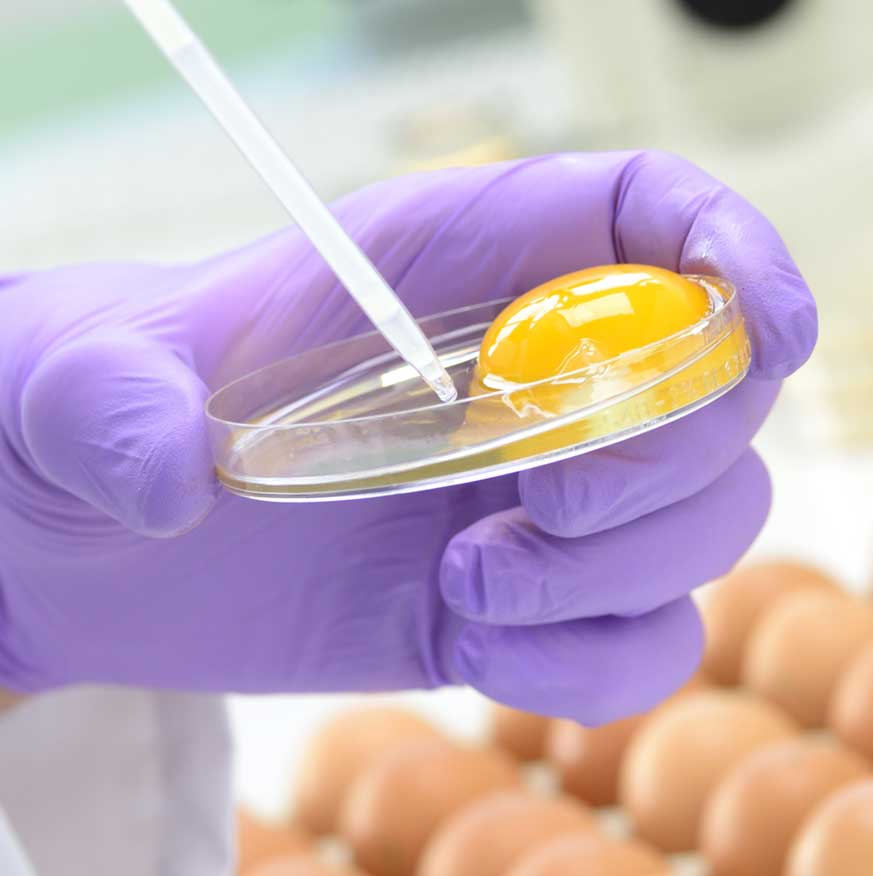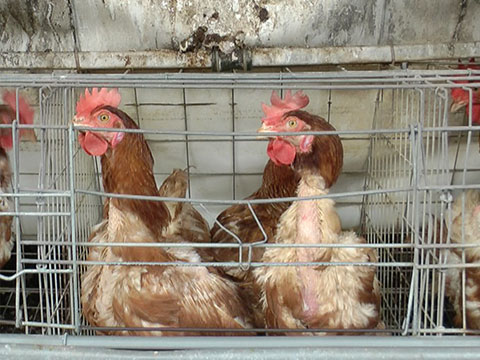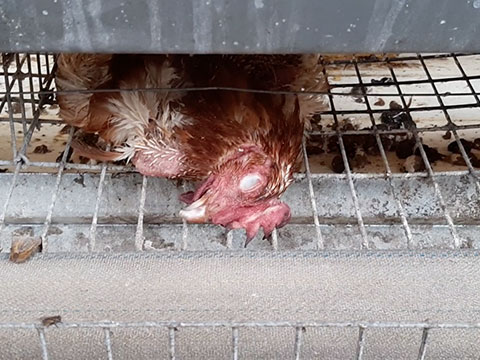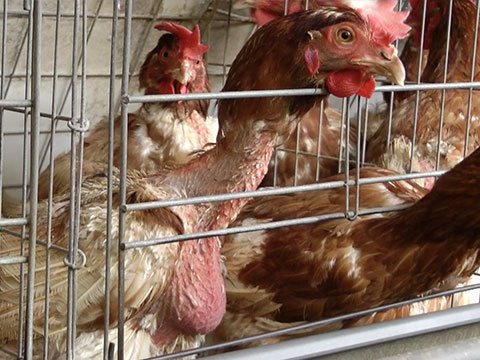
القذارة والقسوة والتمييز
الوجه الآخر لسلسلة إمداد البيض في كارفور
هل تتسوق من المتاجر الكبرى والصغيرة لكارفور؟ إذا كنت تفعل ذلك، فقد ترغب في إعادة النظر في الأمر مرة أخرى. كشفت الأبحاث التي أجريت على سلسلة التوريد في كارفور عن استخدام البيض الذي أصله الدجاج المحبوس في الأقفاص. ستجد في هذه المزارع كمية من القذارة مثيرة للاشمئزاز، بالإضافة للمعاملة القاسية للحيوانات،
يتم تكديس الدجاجات الأم طوال حياتها تقريبًا في أقفاص يطلق عليها أقفاص بطاريات صغيرة وهي مروعة للغاية لدرجة أنها تعتبر غير قانونية في عشرات الدول الأخرى حول العالم.
تُترك جثث الدجاج الميت لتتحلل بجوار الدجاج الذي يضع البيض المخصص للاستهلاك البشري.
التزم العديد من الموزعين الدوليين الرائدين فعلاً باستخدام البيض المنتج من الأقفاص الحرة، بما في ذلك
M&S و Aldi و Costco و CitySuper و Auchan و Tesco و Metro
ولكن على الرغم من التزام كارفور ببيع البيض المنتج من الأقفاص الحرة من العلامة التجارية الخاصة بها، فهي لا زالت تبيع أيضًا أنواعًا أخرى من البيض لعلامات تجارية أخرى من مزارع البيض القذرة والقاسية في أقفاص البطارية.
حان الوقت لكي تتوقف كارفور عن تعريض سلامة المستهلكين للخطر، وتتوقف عن دعم هذه المعاملة القاسية للحيوانات. حان الوقت لكي تلتحق كارفور بمنافسيها وتلتزم بوضع جدول زمني لبيع بيض الأقفاص الحرة فقط في متاجرها في آسيا والعالم أجمع.
أرجوكم وقعوا على العريضة!
كارفور: لن أتسوق في متاجرك مرة أخرى حتى تحذو حذو تجار التجزئة الرائدين الآخرين وتلتزم بالتوقف عن استخدام البيض المنتج في أقفاص البطاريات القذرة والقاسية!/p>

لقد توصلت أكثر من اثنتي عشرة دراسة علمية بأن مزارع البيض المنتج في أقفاص بها معدلات أعلى من عدوى السالمونيلا بشكل كبير.
أجرت هيئة سلامة الأغذية الأوروبية أكبر دراسة على الإطلاق حول هذه القضية، حيث قامت بتحليل البيانات انطلاقًا من خمسة آلاف مزرعة. ووجدت أن مزارع البيض المنتج في أقفاص أكثر عرضة للتلوث بسلالات السالمونيلا الرئيسية مرة.(1, 2, 3, 4, 5, 6, 7, 8, 9, 10, 11, 12, 13, 14, 15, 16, 17)
هناك العديد من الأسباب التي تجعل تكديس الدجاج في أقفاص يسبب مخاطر على سلامة الغذاء. تظهر الأبحاث التي أجرتها وزارة الزراعة الأمريكية أن الإجهاد الناتج عن الحبس في القفص يجعل الدجاج أكثر عرضة للإصابة بالأمراض. كما يصعب تنظيف الأقفاص وتطهيرها، مما يؤدي إلى “زيادة حجم المواد البرازية المعدية والغبار الملوث».(18, 19, 20, 21, 22, 23)
إنتاج البيض في الأقفاص أمر وحشي
مثلما أن الكلاب والقطط أذكياء، فالدجاج كائنات ذكية ويشعرون بالمتعة والألم. وضع حيوان طوال حياته تقريبًا في قفص صغير جدًا بحيث لا يستطيع حتى الاستدارة هو ببساطة أمر خاطئ.(24)
أقفاص البطاريات قاسية للغاية لدرجة أنه تم حظرها في عشرات الدول حول العالم. كل منظمة رئيسية لحماية الحيوانات في جميع أنحاء العالم تندد بأقفاص البطاريات باعتبارها قاسية وغير إنسانية.
(25, 26, 27)
هذا ما قالته بعض هذه المنظمات:

«”تدعو الجمعية الملكية لمنع القسوة على الحيوانات إلى حظر جميع أنظمة الأقفاص… وتدعو لإبقاء الدجاج البيَّاض في أنظمة بديلة مدارة بشكل جيد”»
الجمعية الملكية لمنع القسوة على الحيوانات

«”الدجاج في الأقفاص أكثر عرضة للإجهاد والإصابة، بالإضافة لزيادة خطر الإصابة بالسالمونيلا”»</em
حماية الحيوان في العالم

«”إنه أمر غير إنساني بالنسبة للدجاج – حيوانات ذكية ونشطة – أن تحبس في أقفاص صغيرة جدًا لدرجة أنها بالكاد تستطيع التحرك شبرًا واحدًا طوال حياتها تقريبًا” »
جمعية الرفق بالحيوان الدولية

أقفاص البطاريات
تواصل كارفور بيع البيض للمستهلكين من الموردين الذين يحبسون الدجاج في أقفاص بطاريات قاسية وقذرة

قذر
في موردي البيض إلى كارفور ، يتغوط الدجاج في نفس الأقفاص القاحلة التي يضعون البيض فيها

وحشي
تقضي كل دجاجة أم حياتها كاملة تقريبًا مكدسة في قفص صغير جدًا لدرجة أنها بالكاد تستطيع أن تستدير
التحميل والوثائق
Equitas إيكيتاس هي منظمة غير ربحية مقرها المملكة المتحدة تعمل على حماية حيوانات المزرعة في سلاسل التوريد الخاصة بالشركات.
1: Van Hoorebeke S, Van Immerseel F, Schulz J, et al. 2010. Determination of the within and between flock prevalence and identification of risk factors for Salmonella infections in laying hen flocks housed in conventional and alternative systems. Preventive Veterinary Medicine 94(1-2):94-100.
2: Snow LC, Davies RH, Christiansen KH, et al. 2010. Investigation of risk factors for Salmonella on commercial egg-laying farms in Great Britain, 2004-2005. Veterinary Record 166(19):579-86.
3: 2010. Annual Report on Zoonoses in Denmark 2009. National Food Institute, Technical University of Denmark.
4: Van Hoorebeke S, Van Immerseel F, De Vylder J et al. 2010. The age of production system and previous Salmonella infections on farm are risk factors for low-level Salmonella infections in laying hen flocks. Poultry Science 89:1315-1319.
5: Huneau-Salaün A, Chemaly M, Le Bouquin S, et al. 2009. Risk factors for Salmonella enterica subsp. Enteric contamination in 5 French laying hen flocks at the end of the laying period. Preventative Veterinary Medicine 89:51-8.
6: Green AR, Wesley I, Trampel DW, et al. 2009 Air quality and bird health status in three types of commercial egg layer houses. Journal of Applied Poultry Research 18:605-621.
7: Schulz J, Luecking G, Dewulf J, Hartung J. 2009. Prevalence of Salmonella in German battery cages and alternative housing systems. 14th International congress of the International Society for Animal Hygiene: Sustainable animal husbandry : prevention is better than cure. pp. 699-702. http://www.safehouse-project.eu/vars/fichiers/pub_defaut/Schulz_Salmonella_ISAH%202009.ppt.
8: Namata H, Méroc E, Aerts M, et al. 2008. Salmonella in Belgian laying hens: an identification of risk factors. Preventive Veterinary Medicine 83(3-4):323-36.
9: Mahé A, Bougeard S, Huneau-Salaün A, et al. 2008. Bayesian estimation of flock-level sensitivity of detection of Salmonella spp. Enteritidis and Typhimurium according to the sampling procedure in French laying-hen houses. Preventive Veterinary Medicine 84(1-2):11-26.
10: Pieskus J, et al. 2008. Salmonella incidence in broiler and laying hens with the different housing systems. Journal of Poultry Science 45:227-231.
11: European Food Safety Authority. 2007. Report of the Task Force on Zoonoses Data Collection on the Analysis of the baseline study on the prevalence of Salmonella in holdings of laying hen flocks of Gallus gallus. The EFSA Journal 97. www.efsa.europa.eu/EFSA/efsa_locale-1178620753812_1178620761896.htm.
12: Snow LC, Davies RH, Christiansen KH, et al. 2007. Survey of the prevalence of Salmonella species on commercial laying farms in the United Kingdom. The Veterinary Record 161(14):471-6.
13: Methner U, Diller R, Reiche R, and Böhland K. 2006. [Occurence of salmonellae in laying hens in different housing systems and inferences for control]. Berliner und Münchener tierärztliche Wochenschrift 119(11-12):467-73.
14: Much P, Österreicher E, Lassnig. H. 2007. Results of the EU-wide Baseline Study on the Prevalence of Salmonella spp. in Holdings of Laying Hens in Austria. Archiv für Lebensmittelhygiene 58:225-229.
15: Stepien-Pysniak D. 2010. Occurrence of Gram-negative bacteria in hens’ eggs depending on their source and storage conditions. Polish Journal of Veterinary Sciences 13(3):507-13.
16: Humane Society International, “An HSI Report: Food Safety and Cage Egg Production” (2010). HSI Reports: Farm Animal Protection. 3. http://animalstudiesrepository.org/hsi_reps_fap/3
17: European Food Safety Authority. 2007. Report of the Task Force on Zoonoses Data Collection on the Analysis of the baseline study on the prevalence of Salmonella in holdings of laying hen flocks of Gallus gallus. The EFSA Journal 97. www.efsa.europa.eu/EFSA/efsa_locale-1178620753812_1178620761896.htm
18: The Danish Veterinary and Food Administration. 2004. The national Salmonella control programme for the production of table eggs and broilers 1996-2002. Fødevare Rapport 6, March.
19: Davies R and Breslin M. 2003. Observations on Salmonella contamination of commercial laying farms before and after cleaning and disinfection. The Veterinary Record 152(10):283-7.
20: Methner U, Rabsch W, Reissbrodt R, and Williams PH. 2008. Effect of norepinephrine on colonisation and systemic spread of Salmonella enterica in infected animals: Role of catecholate siderophore precursors and degradation products. International Journal of Medical Microbiology 298(5-6):429-39.
21: Bailey MT, Karaszewski JW, Lubach GR, Coe CL, and Lyte M. 1999. In vivo adaptation of attenuated Salmonella Typhimurium results in increased growth upon exposure to norepinephrine. Physiology and Behavior 67(3):359-64.
22: Shini S, Kaiser P, Shini A, and Bryden WL. 2008. Biological response of chickens (Gallus gallus domesticus) induced by corticosterone and a bacterial endotoxin. Comparative Biochemistry and Physiology. Part B. 149(2):324-33.
23: Rostagno MH. 2009. Can stress in farm animals increase food safety risk? Foodborne Pathogens and Disease 6(7):767-76.
24: Marino, L. 2017. Thinking chickens: a review of cognition, emotion, and behavior in the domestic chicken. Animal Cognition 20(2): 127–147.
25: “European_Union_Council_Directive_1999/74/EC.” Wikipedia: The Free Encyclopedia. Wikimedia Foundation, Inc. Web 03 August 2018, en.wikipedia.org/wiki/European_Union_Council_Directive_1999/74/EC
26: “Farm Animal Confinement Bans.” American Society for the Prevention of Cruelty to Animals. Web. 03 August 2018, www.aspca.org/animal-protection/public-policy/farm-animal-confinement-bans
27: World Organization for Animal Health, “Terrestrial Animal Health Code” (2017). www.rr-africa.oie.int/docspdf/en/Codes/en_csat-vol1.pdf


